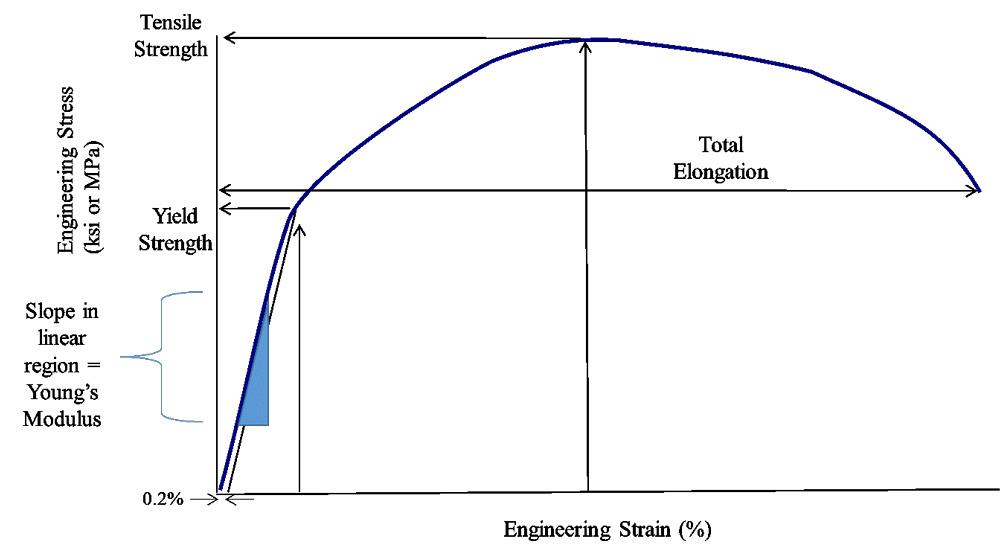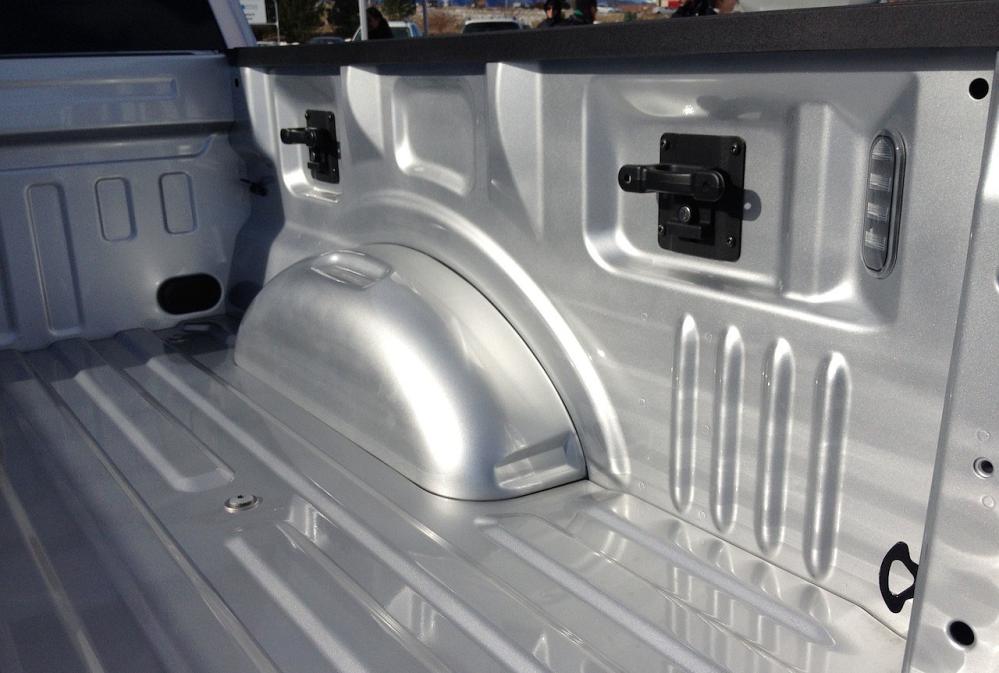President
- FMA
- The Fabricator
- FABTECH
- Canadian Metalworking
Categories
- Additive Manufacturing
- Aluminum Welding
- Arc Welding
- Assembly and Joining
- Automation and Robotics
- Bending and Forming
- Consumables
- Cutting and Weld Prep
- Electric Vehicles
- En Español
- Finishing
- Hydroforming
- Laser Cutting
- Laser Welding
- Machining
- Manufacturing Software
- Materials Handling
- Metals/Materials
- Oxyfuel Cutting
- Plasma Cutting
- Power Tools
- Punching and Other Holemaking
- Roll Forming
- Safety
- Sawing
- Shearing
- Shop Management
- Testing and Measuring
- Tube and Pipe Fabrication
- Tube and Pipe Production
- Waterjet Cutting
Industry Directory
Webcasts
Podcasts
FAB 40
Advertise
Subscribe
Account Login
Search
The differences between stiffness and strength in metal
The terms are not interchangeable as many think
- By Daniel J. Schaeffler
- December 1, 2015
- Article
- Metals/Materials

Figure 1
In a stress-strain curve generated during a tensile test, the slope in the linear portion at the beginning is where Young’s Modulus is determined. Where it first deviates from linearity is the yield strength.
The terms strength and stiffness often are used interchangeably, but they have different meanings and significance.
Strength
Strength is a measure of the stress that can be applied to a material before it permanently deforms (yield strength) or breaks (tensile strength). If the applied stress is less than the yield strength, the material returns to its original shape when the stress is removed. If the applied stress exceeds the yield strength, plastic or permanent deformation occurs, and the material can no longer return to its original shape once the load is removed.
Keep in mind that this permanent deformation is the goal in stamping. The original shape is the flat sheet metal, and formed components need to retain their shape permanently. If the chosen sheet metal cannot be formed into the desired shape under the selected processing conditions, the applied stresses are higher than the tensile strength of the sheet metal, which causes cracks to form in the part.
A material’s strength is a function its chemical composition, the thermo-mechanical processing route (such as converting from a thick slab to a thin sheet), and subsequent heat treatments. These variables make it impossible to state that one material is always stronger than another. For example, many aluminum grades are stronger than steel grades, but rarely are they intended for the same application.
Stiffness
Stiffness relates to how a component bends under load while still returning to its original shape once the load is removed. Since the component dimensions are unchanged after load is removed, stiffness is associated with elastic deformation.
At one extreme, a rubber band is an example of a material with low stiffness—it can withstand a lot of deformation and still return to its original dimensions when the load is removed. On the other hand, a high-stiffness material like diamond will elastically deform only a small amount when load is applied.
Stiffness of a component is a function of both material and geometry. On the material side, stiffness depends on the modulus of elasticity, also known as Young’s Modulus and abbreviated as E. Young’s Modulus is the ratio of stress to strain at very small strains. In a stress-strain curve generated during a tensile test, the slope in the linear portion at the beginning is where the modulus is determined. Where it first deviates from linearity is the yield strength (see Figure 1).
Unlike strength, which can vary from grade to grade or even coil to coil, Young’s Modulus is constant for a given metal and is independent of heat treatment, processing, or cold work. Young’s Modulus for steel (29 million PSI) is three times that of aluminum (10 million PSI). This means that for a fixed geometry, a part made out of steel will be three times as stiff as if it were made out of aluminum. In other words, an aluminum part under load will deflect three times as much as a similarly loaded steel part.
The thickness and shape of the formed part also contributes to its stiffness. Stiffness is proportional to the cube of the thickness. To neutralize aluminum being one-third the stiffness of steel, an aluminum part must be made 44 percent thicker than the steel part. Even with this increased thickness, there is a potential for weight savings since aluminum is one-third the density of steel.
Having more shape in the part also increases stiffness. A piece of paper is flimsy, but putting a crease down the center of it makes it more rigid. Darts, beads, and ribs are shapes that can be added to parts to restrict flexing. On surface parts visible to the consumer, they are called feature lines or character lines, highlighted for their aesthetic benefits.

Figure 2
Ribs are added to truck bed designs to help increase overall stiffness. (Source: www.tfltruck.com/2014/11/2015-ford-f-150-2-7l-v6-ecoboost-first-impressions-w-video)
For instance, the panels that comprise a pickup truck bed (see Figure 2) are some of the flattest on the truck. Yet there isn’t a truck on the market that is designed without these ribs to help increase overall stiffness.
However, the sheet metal needs to be sufficiently formable to accommodate the additional shapes. The ribs in the truck bed panel might not be very deep, but the metal needs to be stretched over short distances. A higher-tonnage stamping press also is needed to generate the required forces over the entire panel.
Aluminum Versus Steel in Automobiles
For skin panels such as hoods, doors, and liftgates, automakers prefer to use a sheet metal with as high a strength as possible so that the panel has sufficient dent resistance. Thickness affects dent resistance as well, limiting the degree to which panel thickness can be reduced to decrease weight.
Stiffness constraints further limit how thin the skin panels can be. If the panels are too thin, they might start to wave and flutter as the vehicle travels down the road—unless character lines are put in for extra style.
Although it might sound obvious, automakers also need to specify a sheet metal product that can be produced to Class A surface standards. Current technology limits this to sheet steel or aluminum with strength less than 45,000 PSI. Joining is not a significant hurdle, since several cost-effective techniques are available to mate the outer panel to the inner panel.
With a similar upper strength available in either material, and several grades from several suppliers of either metal that can be produced sufficiently thin, the one offering the best combination of cost and weight savings will emerge as the optimum choice for hang-on panel applications.
Body structure applications present different challenges. Stiffness is important for handling and noise, vibration, and harshness (NVH). In addition to the inherent stiffness associated with the part’s material and geometry, NVH characteristics can be improved with lightweight polymer foams. Crash resistance, on the other hand, is more closely associated with strength. For the same design, steel has a significant advantage in available choices. If a Class A surface is not required, steel grades are available commercially with tensile strength exceeding 230,000 PSI.
This isn’t to say that aluminum body structures are not possible. There are many examples on the market, although they skew toward more expensive vehicles in which lightweighting for fuel economy improvements is not a primary issue and the sheet metal cost is a smaller percentage of the transaction price.
Improved crash performance will come with higher strength, as well as components that have crash-resistant designs, such as closed sections, larger flanges, or more shape—all of which might require greater formability from the higher-strength aluminum grades.
Furthermore, these parts must be joined in a robust, high-speed, cost-effective manner. Ford spent nearly $1 billion to rebuild the F150 plant to stamp and assemble the aluminum-intensive cab and bed and join it to a steel frame. This financial hurdle may limit the number of automakers willing to go all-in and make an aluminum-intensive body structure.
Daniel J. Schaeffler is president of Engineering Quality Solutions Inc., P.O. Box 187, Southfield, MI 48037, 248-667-8335, sales@eqsgroup.com, www.eqsgroup.com, and chief content officer with 4M Partners LLC, P.O. Box 71191, Rochester Hills, MI 48307, www.learning4m.com.
About the Author

Daniel J. Schaeffler
P.O. Box 187
Southfield, Michigan 48037
248-539-0162
subscribe now

The Fabricator is North America's leading magazine for the metal forming and fabricating industry. The magazine delivers the news, technical articles, and case histories that enable fabricators to do their jobs more efficiently. The Fabricator has served the industry since 1970.
start your free subscription- Stay connected from anywhere

Easily access valuable industry resources now with full access to the digital edition of The Fabricator.

Easily access valuable industry resources now with full access to the digital edition of The Welder.

Easily access valuable industry resources now with full access to the digital edition of The Tube and Pipe Journal.
- Podcasting
- Podcast:
- The Fabricator Podcast
- Published:
- 04/16/2024
- Running Time:
- 63:29
In this episode of The Fabricator Podcast, Caleb Chamberlain, co-founder and CEO of OSH Cut, discusses his company’s...
- Trending Articles
AI, machine learning, and the future of metal fabrication

Employee ownership: The best way to ensure engagement

Steel industry reacts to Nucor’s new weekly published HRC price

Dynamic Metal blossoms with each passing year

Metal fabrication management: A guide for new supervisors

- Industry Events
16th Annual Safety Conference
- April 30 - May 1, 2024
- Elgin,
Pipe and Tube Conference
- May 21 - 22, 2024
- Omaha, NE
World-Class Roll Forming Workshop
- June 5 - 6, 2024
- Louisville, KY
Advanced Laser Application Workshop
- June 25 - 27, 2024
- Novi, MI


























